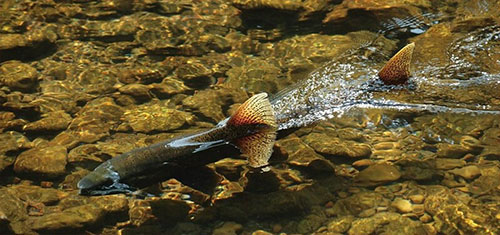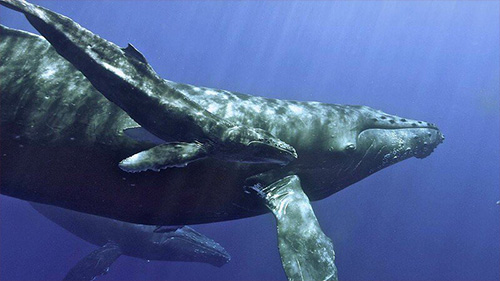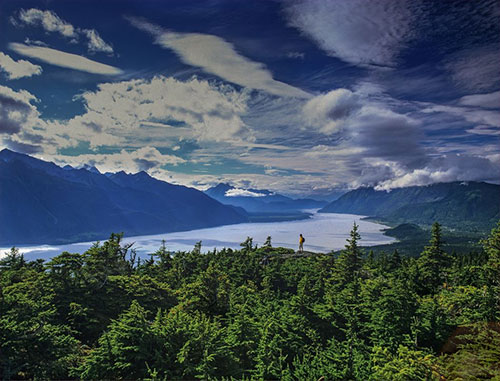











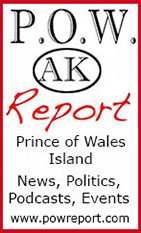

 Contact Contact 
 Webmail
Letters Webmail
Letters
 News Tips News Tips
 Copyright Info Copyright Info
 Archives Archives
Quick News
Search
 Alaska Alaska
 Ketchikan Ketchikan
 SE Alaska SE Alaska
Columns
- Articles
 Dave Kiffer Dave Kiffer
 Money Matters Money Matters
Historical
Ketchikan
 June Allen June Allen
 Dave
Kiffer Dave
Kiffer
 Louise
B. Harrington Louise
B. Harrington
Sports
 Ketchikan Links Ketchikan Links
Public Records
 FAA Accident Reports FAA Accident Reports
 NTSB
Accident Reports NTSB
Accident Reports
 Court Calendar Court Calendar
 Recent Filings & Case Dispositions Recent Filings & Case Dispositions
 Court Records Search Court Records Search
 Sex Offender Reg. Sex Offender Reg.
 Public Notices Public Notices
 Alaska Recall Alerts Alaska Recall Alerts
 Recalls.gov Recalls.gov
 AST Daily Dispatch AST Daily Dispatch
 KTN
Police Reports KTN
Police Reports
 Juneau Police Reports Juneau Police Reports
Weather,
Webcams
 Today's
Forecast Today's
Forecast
 KTN
Weather Data KTN
Weather Data
 AK
Weather Map AK
Weather Map
 AK Weathercams AK Weathercams
 AK Earthquakes AK Earthquakes

|
|

January 12, 2022
Wednesday PM
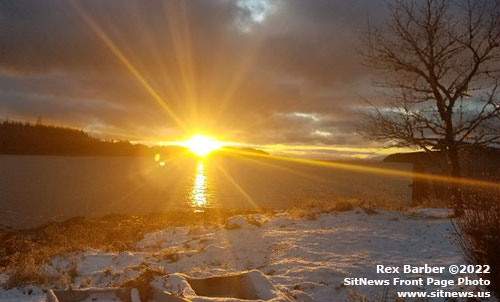
Winter Sunset: Loring
SitNews Front Page Photo by REX BARBER ©2022
To have your photo(s) featured on the front page,
email your photo(s) to editor@sitnews.us |
|
Ketchikan Historical: When "54-40 or Fight" Was the Presidential Cry By DAVE KIFFER - In the 1844 United States Presidential election, all eyes were towards Southeast Alaska.
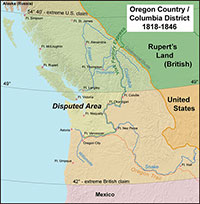
The Oregon Country/Columbia District stretched from 42°N to 54°40′N. The most heavily disputed portion is highlighted.
Courtesy Wikimedia Commons |
Well, not really Southeast Alaska. The eyes were toward the boundary of Russian America and the "Oregon Territory."
And, actually, most of the eyes were on Texas, but the election slogan of Democratic candidate James Polk of Tennessee was “54-40 or fight.” Which, as all cartographers know, is the latitude that runs roughly through the center of Dixon Entrance.
Confused?
It all goes back to “Manifest Destiny.”
In 1844, the idea that America should expand to “from sea to shining sea” was a popular one in the half-century-old republic. Those in the South favored the annexation of Texas, which had been “independent” from Mexico since 1836. Southerners saw the annexation as a way to add political power to the pro-slavery side in the debate that was fracturing America into north and south.
That annexation would eventually bring the US into conflict with Mexico and allow further American expansion into the Southwest by the end of the decade.
In order to counter “expansion” in the South, Northerners favored resolving the long running dispute between the United States and Great Britain over the “Oregon Territories” and then creating “states” in that region that would be non-slave states
The north Pacific coasts of what are now Washington, Oregon and British Columbia had always been in contention. At one point, they were claimed by Russia, Great Britain, the United States and Spain. Even the French had their eye on the area at one point.
After the War of 1812, control of the Oregon “territories” was shared, suspiciously, by the United States and Great Britain. The only thing the two sides generally agreed on was that the territory south of the Columbia River belonged to the United States and the territory north of Puget Sound belonged to the British. British Territory ended where Russian America began, at 54 degrees, 40 minutes north latitude, as established in the Russo-British treaty of 1825.
At to the territory in the middle, which was what is now much of Washington state, the relationship would remain “complicated” until the mid-1840s.
Between the 1810s and the 1840s, as Americans poured into the Oregon Territory, there were numerous disputes which led the British to suggest they should control the territory all the way down to the Spanish border in Northern California and also led the Americans to suggest they should control “Oregon” all the way north to the Russian border at 54’ 40.”
Polk’s opponent in the 1844 election was Henry Clay of the Whig Party.
The Whigs had partially risen from the defunct Federalist party earlier in the century, but were also a conglomeration of several smaller parties. As a result, Whig policies were often crafted to meet a variety of interests.
The Whigs were not opposed to manifest destiny, but they were not strongly in favor of it either. - More...
Wednesday PM - January 12, 2022
Alaska: State forestry offering virtual wildland firefighting class in February - Alaskans looking to start a career in wildland firefighting don’t have to wait until spring to take a class that will qualify them to work this summer.
The Alaska Division of Forestry is piloting a new basic wildland firefighting (Red Card) class to be held Feb. 14-25. The course will be offered statewide through the online Navigate platform and features both virtual and in-person components. Students need access to a computer with a webcam and microphone, as well as high-speed internet.
The registration deadline for the class is Feb. 8, 2022. Students can register online. Cost is $55 with purchase of an e-book or $73 for a paperback book. Students may apply for financial assistance if they cannot afford the class.
The class includes an in-person field day at a local Area office later this spring. Students can schedule a date and location for their field day and fitness test when they register. Students must participate in the field day and pass a fitness test to complete the class. Upon completion of the class, field day and fitness test, students will be eligible to receive a Red Card to work on a crew or in other wildland firefighting support positions.
The virtual component of the class will take approximately 30 hours with a daily time commitment of 2-3 hours for self-study. The class will feature daily Zoom meetings, quizzes and a final exam that students must achieve a minimum score of 70 percent. Instructors will be available via email or phone to answer questions as they come up. - More...
Wednesday PM - January 12, 2022
|
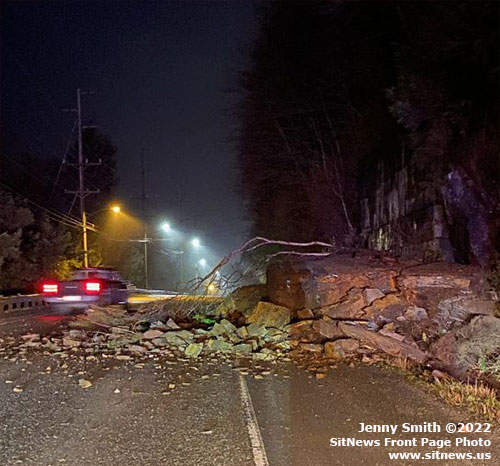
Rockslide
Wednesday evening in the area of 4.5 North Tongass, between Wolff Point Scenic turnout and Ketchikan Dray there was a rockslide dumping rocks on to the main highway lane going north. Last month there was a rockslide in this same area. These kinds of rockslides generally happen in the winter months during periods of freezing and thawing. Water enters cracks in the bedrock and freezes, expanding the cracks. Eventually, this area may slide again.
(Note: Almer Wolff's (1900-1970) personal campaign helped turn what was once a garbage dump into what is now a community asset, Wolff Point scenic turnout.)
SitNews Front Page Photo by JENNY SMITH©2022
To have your photo(s) featured on the front page,
email your photo(s) to editor@sitnews.us |
|
Fish Factor: A lot of fishing going on; Halibut watch; Covid cans Ketchikan; & Good global outlook By LAINE WELCH - Wow, there is a lot of fishing going on across Alaska!
Salmon is the heart of Alaska’s seafood industry but winter is when the fishing action really begins.
Hundreds of boats are out on the water on the first day of each new year, beginning a predictable rhythm for the seafood industry as millions of pounds of fish begin to cross the docks around the clock at Alaska’s working waterfronts. Here’s a sampler:
Starting January 1 boats drop pots and baited lines for cod, rockfish and other whitefish in the Gulf of Alaska and the Bering Sea.
Alaska pollock, the nation’s largest food fishery, opens to trawl fishing on January 20.
A Tanner crab fishery opens on January 15 at Kodiak, Chignik and the South Peninsula with a combined catch of 1.8 million pounds.
Tanner crab and golden king crab fisheries open in Southeast Alaska on February 11. A Tanner crab fishery also opens in Prince William Sound on March 1.
Bering Sea crabbers are fishing for Tanners and golden king crab and will start dropping pots for snow crab this month.
Southeast divers are wrapping up a nearly 1.9 million pound sea cucumber harvest; divers also are still digging up giant geoduck clams in some regions.
Trollers are pulling up Chinook salmon in a fishery that will close on March 15. They’ve taken 6,219 winter kings so far, each valued at $122.43.
Halibut watch:
Pacific halibut catches for 2022 will be announced at the annual International Pacific Halibut Commission meeting held online January 24-28, and fishermen are hoping for another year of increased catches when the fishery opens in early March.
Last year’s coastwide catch limit was 39 million pounds for fisheries spanning from California and British Columbia to the far reaches of the Bering Sea.
Alaska always gets the lion’s share and in 2021fishermen holding shares of the catch took 93% of their 18.5 million pound limit by the time the fishery closed on December 7, one month longer than usual. Homer, Seward, Kodiak and Juneau and Sitka were top ports for halibut landings.
The average price paid to Alaska fishermen for halibut in 2021 was $6.40/lb bringing the fishery value to $109,129,240, according to NOAA data. That compares to a 2020 dock price of $4.12/lb and a fishery value of $61,778,449.
Covid cans Ketchikan:
The Covid pandemic has derailed the AK Board of Fisheries meeting that planned to meet in-person from Jan.4-15 in Ketchikan.
The Board oversees management of Alaska commercial, sport, subsistence and personal use fisheries in state waters out to three miles.
The meeting, set to address 157 Southeast and Yakutat fishery issues, has been “postponed to a future date and location to be determined” according to Doug Vincent-Lang, Alaska Department of Fish and Game Commissioner in a press release.
“Cases in Southeast are increasing in almost every community. With the rise in cases post the holiday season, already key staff have contracted COVID-19 and are unable to participate. In addition, the nation and Alaska are facing serious transportation difficulties as weather and the pandemic are seriously hampering travel in the near-term,” Glenn Haight, BOF Executive Director said in the announcement.
Adding to the challenge is the resignation of newest BOF member, Indy Walton of Soldotna, who Gov. Dunleavy appointed last September. Walton named “medical issues and his busy business schedule as considerations in his decision.”
Walton was named to the BOF by Gov. Dunleavy nearly three months beyond a legal deadline, and he was not yet approved by the Alaska legislature. He has fished for salmon commercially for nearly 40 years at Kodiak and Bristol Bay and also owns a fishing lodge on the Kvichak River.
Nominations for Walton’s seat will be accepted until Dunleavy names his appointment, said deputy director of communications, Jeff Turner. The appointee must then be approved by the Alaska Legislature. - More...
Wednesday PM - January 12, 2022 |
|
Alaska: New research on magnetite in salmon noses illuminates understanding of sensory mechanisms enabling magnetic perception across life By MICHELLE KLAMPE - It’s widely understood that animals such as salmon, butterflies and birds have an innate magnetic sense, allowing them to use the Earth’s magnetic field for navigation to places such as feeding and breeding grounds.
But scientists have struggled to determine exactly how the underlying sensory mechanism for magnetic perception actually works.
In a paper published this week in the Proceedings of the National Academy of Sciences, an international team of researchers, including scientists from Oregon State University, outlines a new theory. Magnetite crystals that form inside specialized receptor cells of salmon and other animals may have roots in ancient genetic systems that were developed by bacteria and passed to animals long ago through evolutionary genetics.
The theory is based on new evidence from nanoscopic magnetic material found within cells in the noses of salmon. The paper’s lead author is Renee Bellinger, who began the research as a doctoral student at Oregon State, completing her Ph.D. in fisheries science in 2014.
“The cells that contain magnetic material are very scarce,” said Bellinger, who now works as a research geneticist at the U.S. Geological Survey and is affiliated with the University of Hawaii, Hilo. “We weren’t able to definitively prove magnetite as the underlying key to magnetic perception in animals, but our study revealed associated genes as an important tool to find new evidence of how potential magnetic sensors may function.”
“Finding magnetic receptors is like trying to find a needle in haystack. This work paves the way to make the ‘needle’ glow really bright so we can find and understand receptor cells more easily,” Bellinger said.
The findings have the potential for widespread application, from improving salmon management through better understanding of how they use the ocean to targeted medical treatments based on magnetism, said coauthor Michael Banks, a fisheries genomics, conservation and behavior professor at Oregon State.
“Salmon live a hard and fast life, going out to the ocean to specific areas to feed and then coming back to their original spawning grounds where they die. They don’t have the opportunity to teach their offspring where to go, yet the offspring still somehow know where to go,” Banks said. “If we can figure out the way animals such as salmon sense and orient, there’s a lot of potential applications for helping to preserve the species, but also for human applications such as medicine or other orientation technology.” - More...
Wednesday PM - January 12, 2022
Southeast Alaska: SouthEast Alaska Regional Health Consortium Announces Crossings Closure in Wrangell - Health care systems throughout the United States have been dramatically impacted by the COVID-19 pandemic and the SouthEast Alaska Regional Health Consortium (SEARHC) has not been immune. SEARHC’s adolescent residential treatment programs have been especially impacted, experiencing a significant decrease in patient volume, serious staffing pressures, drastically rising costs, and infrastructure challenges requiring substantial future capital investment. These realities have forced SEARHC to re-examine how residential services are delivered and how we can continue to provide high quality care.
After a considerable discernment process, SEARHC said they made the extremely difficult decision to permanently close Crossings in Wrangell as of January 12, 2022 and unify adolescent residential services into the current, recently expanded Raven’s Way program based in Sitka. SEARHC said this move to consolidate and optimize resources ensures they will continue a sustainable adolescent program centered on evidenced based substance abuse treatment, wilderness experiences, classroom learning, and Native cultural activities for years to come. The Crossings 2021 season recently ended so the closure will have no impact on direct patient care. - More...
Wednesday PM - January 12, 2022
|
|
Fisheries: Lawsuit Aims to Protect Pacific Humpbacks From Deadly Fishing Gear; West Coast Pot Fishery Unlawfully Entangles Endangered Whales - The Center for Biological Diversity sued the National Marine Fisheries Service Monday for failing to protect endangered Pacific humpback whales from deadly entanglements in sablefish pot gear off the coasts of California, Oregon and Washington.
Monday’s lawsuit challenges the federal permit given to the fishery in December to kill and injure endangered humpback whales without any changes to avoid harming whales. Fishing gear entanglements are a leading threat to endangered humpbacks that migrate along the West Coast, where 48,521 square nautical miles were designated as critical habitat in April.
“These migrating whales shouldn’t have to dodge deadly commercial fishing gear, especially in national marine sanctuaries,” said Catherine Kilduff, a Center attorney. “This is critical habitat for endangered humpbacks, but it’s full of long strings of fishing pots. It’s outrageous that the Fisheries Service rubber-stamped the status quo despite growing threats to these whales. Humpbacks are our magnificent, acrobatic neighbors, and we need to stop the increasing deaths in commercial fishing gear.”
As climate change alters migration patterns and availability of food for whales, it’s harder for endangered humpbacks to avoid commercial fishing gear. Until last month, the West Coast fisheries for the bottom-dwelling sablefish — also known as butterfish or black cod — had operated for five years without authorization to take whales under the Endangered Species Act and Marine Mammal Protection Act.
According to Fisheries Service estimates, the sablefish fishery on average kills or seriously injures about two humpback whales every year. The fishery uses 2-mile-long strings of 30 to 50 pots. Commercial fisheries in total entangle 25 humpback whales annually off the U.S. West Coast; more than half of the entanglements are not identified as being tied to a specific fishery.
The lawsuit, filed in U.S. District Court in Northern California, focuses on several deficiencies in the Fisheries Service’s analyses of the sablefish fishery’s impact. These include outdated humpback whale stock assessments, the failure to recognize the smallest humpback population — that winters in Central America — as distinct, and the failure to consider the Fisheries Service’s own analyses of the growing whale entanglement threat.
The Service found a 400% increase in humpback mortality and serious injury from human activities, including vessel strikes, since 2018 estimates. - More...
Wednesday PM - January 12, 2022
|
|
Alaska: “Alaska’s untold secret” — the dividends paid by Southeast Alaska’s “Seabank” By MARY CATHARINE MARTIN - Wild salmon. Clean water. Clean air. Carbon storage. Climate change mitigation. Tourism, commercial fisheries — and billions of dollars in economic benefit.
Since 2018, the Alaska Sustainability Fisheries Trust (ASFT) has quietly published reports that upend managers’ historical ways of thinking about Southeast Alaska and the Tongass National Forest — and redefine priorities for management now and in the future. ASFT’s annual “SeaBank” report outlines and quantifies the benefits flowing from Southeast Alaska’ trees, estuaries, creeks, lakes, rivers, coasts, ocean and more. These benefits include goods and services that annually “renew,” provided that the natural capital on which they depend is never “overdrawn.”
In the language of the SeaBank, Southeast Alaska’s natural capital produces economic outputs from the seafood and visitor products industries worth several billion dollars a year to Southeast Alaska residents, non-resident workers, visitors and society as a whole. Ecosystem services provide this stream of income as natural capital. It’s a complex interplay of plant and animal communities and their environment that interact as one functional unit – SeaBank.
“The 2020 SeaBank report underscores that Southeast Alaska is one of the most productive ecosystems in the world,” said Alaska Sustainable Fisheries Trust founder and Sitka-based commercial fisherman Linda Behnken. “Southeast Alaska’s natural capital produces economic outputs worth several billion dollars a year, every year, to Southeast residents, visitors and society as a whole. This coastal ecosystem is also incredibly vulnerable to a rapidly warming climate and industrial activities that diminish the productivity of the underlying natural capital.”
ASFT released its 2020 SeaBank report at the end of last year. While the 129-page report contains a treasure trove of information to anyone looking to ensure the long-term profitability of the region, some key findings are: - More...
Wednesday PM - January 12, 2022
|
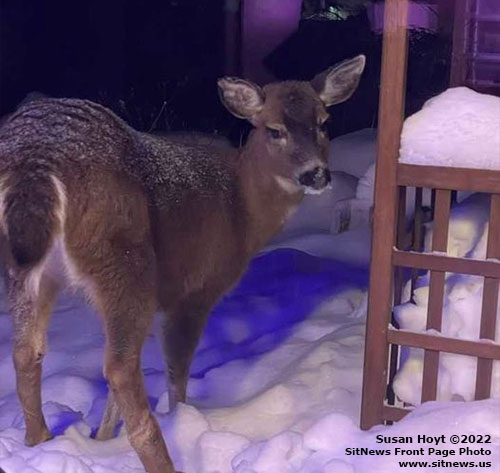
Sitka Black-tailed Deer
Just passing through a South Tongass yard during the recent snowy, freezing weather.
SitNews Front Page Photo by SUSAN HOYT ©2022
To have your photo(s) featured on the front page,
email your photo(s) to editor@sitnews.us |
CARL GOLDEN: BUILD BACK LATER - Build Back Better, the centerpiece of President Biden’s ambitious domestic legislative agenda, has become Build Back Later…maybe.
What was to have been the administration’s history-making signature accomplishment – a $1.75 trillion expansion of existing social welfare programs and the creation of new entitlements – now lies in ruins and the odds of its resurrection are beyond bleak.
What was to have arrested the president’s downward spiral in public support resulted instead in a further erosion of confidence in the administration’s competence. (The Real Clear Politics polling average, for instance, places Biden’s approval at 42 percent and disapproval at 53 percent.)
What was to have provided a record of achievement for Democratic congressional candidates to campaign on this year has instead highlighted the internal fissures in the party while adding greatly to their fears of a Republican sweep and seizing control of Congress. - More...
Wednesday PM - January 12, 2022
CHRISTINE FLOWERS: WHAT SIDNEY POITIER TAUGHT US ABOUT OURSELVES - When my sister texted to tell me that Sidney Poitier had passed away, I started crying.
All I could do was conjure up the black and white image of a beloved movie, “A Patch of Blue,” the film that made me fall in love with Poitier. It’s a powerful movie that carries as strong a message about anti-racism as “Guess Who’s Coming To Dinner,” without its political posturing and preachiness.
It’s a simple story, about a young blind woman with an abusive mother and a loving but alcoholic “Opa,” or grandfather. One day, sitting in the park and working on the necklaces she sells to bring in a little money, a storm arises and her carefully organized tray of beads spills out onto the grass. It’s at that point that the Poitier character, passing through the park, runs to help her. A friendship develops. That friendship turns into love, at least from the young girl’s perspective. Poitier’s affection is a complicated mixture of attraction, brotherly protection and pity. - More...
Wednesday PM - January 12, 2022
 |
SAM MARCUM: If You’re Starting a New Business, Don’t Make One of These 5 Common Mistakes - When starting a new business, you are bound to make at least several mistakes. No one has ever perfectly launched and run a business; therefore, it is important to give yourself some grace when embarking on your entrepreneurial journey. You can also prepare yourself in advance for some of the more common mistakes that new business owners tend to make.
SitNews shares five common errors that you can learn prior to launching your new company.
Not understanding how to properly run a business
While it is true that you don’t need formal business training to start a business, a significant number of people jump into entrepreneurship with zero understanding of how to run an organization. This includes knowing what permits and licenses are required, how to create a business plan, and how to keep track of profits and losses. Having at least a basic idea of how to do these things (and others) is essential in successfully starting your new company. - More...
Wednesday PM - January 12, 2020
FINANCIAL FOCUS: What should you know about investment risk? Provided By BEN EDWARDS, AAMS® - When you invest, you incur risk – there’s no avoiding it. But the concept of “risk” may be more expansive than you realized. And by understanding the different types of investment risk and how these risks can be addressed, you can improve your skills as an investor.
The most common perception of investment risk is simply the risk of losing money. When you invest in stocks and stock-based vehicles, such as mutual funds, there are no guarantees that your principal – your initial investment amount – will be preserved. Generally speaking, if you hold stocks or mutual funds over a period of years, and even decades, you can reduce the likelihood of sustaining losses that could send your investments’ value to zero. Hopefully, the value of your investments will rise over time. And it’s worth noting that, since the Great Depression, U.S. stocks have averaged 9.59% annual returns, according to Morningstar Direct, an investment research service. However, past performance can’t guarantee future results. - More...
Wednesday PM - January 12, 2022
|
POLITICAL CARTOONS

Political Cartoon: Inflate Gate
by Christopher Weyant, The Boston Globe, MA
Distributed to subscribers by CagleCartoons.com

Political Cartoon: Dems and MLK JR
by Gary McCoy, Shiloh, IL
Distributed to subscribers by CagleCartoons.com

Political Cartoon: A Kingdom Divided
by Rivers, CagleCartoons.com
Distributed to subscribers by CagleCartoons.com

Political Cartoon: Midterm elections 2022
by Dave Granlund, PoliticalCartoons.com
Distributed to subscribers by CagleCartoons.com

Political Cartoon: Woke DA's
by Dick Wright, PoliticalCartoons.com
Distributed to subscribers by CagleCartoons.com |
Candidacy and Concerns for KIC Tribal Council
By Debi White
- My Fellow Tribal Members, My name is (Debi) A. White. I am of Tsimshian/Blackfoot descent, Mather family/Wolf Clan. Married to Charles White, Past KIC Tribal Administrator/Tribal Council. Mother, Barbara A. Pearce, Father (Late) Douglas Pearce.
I am a lifetime KIC member, Employed for 28 years at KIC as the JOM/477 Director, twelve years as a consultant to other tribes in the lower 48. As a past KIC employee, I was given such opportunity to develop wonderful working relationships with KIC employees and tribal administration. If elected to the tribal council, I will continue with such, to strongly support our administration and staff. It is their hard work and dedication that makes KIC a success. My 40 years of working with tribes provided me the opportunity to learn from many, develop skills to do extensive work with local, state and federal agencies. The skills I have developed will be of assistance in program development, dealing with budget constraints, prioritization within strategic planning, tribal representation, negotiations and cultural responsiveness.
There are many important issues facing our tribe today, and I believe my work and volunteerism will be an asset in helping this council to come to good sound decisions for our people and stay well informed on all issues. The votes or decisions I make will be for the sole benefit of you, the KIC Tribal members and KIC overall. - More...
Wednesday PM - January 12, 2022
Disloyal Football Bowl Dropouts By Donald Moskowitz - As a Penn Stater, class of 1963, I was disappointed with six starting football players who dropped out of the recent Outback Bowl. Five were defensive starters, which crippled the Penn State defense. Coach Franklin said it was the worst bowl optout situation he has experienced. Happily, the Big Ten record in the bowls was 6 and 4.
Players dropping out of bowl games for fear of being injured prior to the NFL draft is disconcerting. Injuries can occur anytime during their careers. Most of the players were on four year scholarships and committed to play the football seasons, which includes bowl games.
The NCAA and athletic conferences have to address this problem because it demeans the significance of bowl games and compromises the spirit of college athletics. - More...
Wednesday PM - January 12, 2022
Harbor users insurance requirement discussion By A. M. Johnson- I am a borough resident renting a stall in the Ketchikan boat harbor, Bar Harbor North. In regard to the recent December article in the Ketchikan Daily News on the topic of boat insurance as a requirement of harbor moorage.
This has been a sore subject with me for several, actually, many years. Off and on over those years, all the boats free and clear that I have owned and that is a number, I have voluntarily purchased liability insurance to cover potential issues that would entice a civil law suit or that of a governmental settlement for damage that I as the boat owner, would be liable. This action on my part was labeled "Common Sense" part of boat ownership. Why moor your boat with the threat of extreme civil cost were there to be an incident in your absents, or in the act of maneuvering in the harbor to the facility or a fellow boater's boat?
On several occasions over the years, particularly those times that the harbor moored a "Shit Boat" in the stall next or near my boat. I would ask the harbor personnel if there was any provision to have a boat owner prove responsible background when obviously the craft is a unfit boat. Who is to determine what is unfit? Well, that opens up the discussion that you find yourselves in.
In reading the article the number of red herring comments in opposition to establishing a insurance requirement was obvious, most upsetting was seemingly the opposition from the very personnel that should be in favor of addressing a fix.
Scratching my head as I read, the complexity of the opposition was mind boggling, How could a simple challenge become so twisted to require hours of discussion with no resolve? - More...
Saturday PM - January 01, 2022
Annual KIC Elections Jan. 17th By Charles (Chas) Edwardson - Ketchikan Indian Community annual elections are coming up on January 17, 2022. I am currently on the tribal council and hope to continue working for our community after the next election.
Although we are a tribal entity here in Ketchikan, our economic impact as a tribe in Ketchikan is significant and greatly beneficial to the broader community.This current and past councils have been active with financial contributions to many great non profit organizations that assist those in need both tribal and non tribal citizens of our city that we all love.
Our annual budget and compacts with the federal government that the tribe administers Are significant, and used for primarily health care , education, health and social services , and is predominantly spent right here in Ketchikan. Purchasing goods and services from local vendors and utilizing peace health, our local pharmacy’s, grocery stores, fuel companies,insurance companies , realtors , construction companies , construction supply stores, equipment rental, advertising companies , shipping companies just to name a few all local ,,and are impacted by a healthy and robust Ketchikan Indian community.
During these unprecedented times Ketchikan was not spared the onslaught of a pandemic that is disrupting the world as we know it.
Ketchikan Indian community was hit especially hard, but reacted swiftly and efficiently under the timely decisive leadership of Charles (Charlie) white, who navigated us through that uncertain time with little fear and a can do attitude that we needed during the onset of the pandemic we will be forever grateful for Charlie and his unwavering optimism that we will get through this ,Ketchikan Indian community was one of the first organizations in Ketchikan to receive and administer the Covid vaccine , and one of the first organizations to distribute the first Cares act covid relief funds in Ketchikan, distributing 8 million dollars in direct assistance to our tribal members , with a multiplier effect of every dollar spent in the community that changes hands 3 times . - More...
Saturday PM - January 01, 2022
 |
2021 proved that Murkowski has abandoned Alaska By Kelly Tshibaka
- As we enter 2022, it’s time to examine the record of Alaska’s senior senator, Lisa Murkowski, over the last year. After strongly opposing the election of President Donald Trump and helping Joe Biden take power, Murkowski immediately set about enabling Biden’s radical agenda.
On his first day in office, Biden blocked energy exploration in ANWR, and then nominated Deb Haaland, known as a radical environmentalist, for Interior Secretary. Even though Murkowski expressed concerns that Haaland would be harmful to Alaska, she cast the deciding vote in committee to confirm her. Except for Murkowski, Haaland never would have become Interior Secretary.
When a federal judge blocked Alaska’s massive Willow oil and gas project, Haaland refused to appeal the decision. Haaland also obstructed a federal court ruling that would re-open ANWR by claiming her Department needed to redo an environmental survey. These foreseeable Haaland decisions have cost Alaska billions of dollars and thousands of jobs, all of which reflect Murkowski’s commitment to her constituency of one—Joe Biden—rather than all the Alaskans she was elected to represent.
But Haaland’s assault on Alaska is about more than just energy.
She is pushing to close off 60 million additional acres of federal public lands to hunting next year, and she has refused to honor multiple US Supreme Court decisions that upheld Alaska’s right to manage its navigable waters. To enforce our rights, the State is expending significant resources battling the radical-environmentalist chief lawyer at the Department of Interior. Guess who cast the tiebreaking vote for his confirmation? Lisa Murkowski. - More...
Saturday PM - January 01, 2022
 |
Open Letter to Dr. Ann Zinc, Alaska Chief Medical Officer By Ceri Malein - I am writing about possible Covid super spreading stemming from the upcoming Alaska Board of Fisheries (BOF) meetings in Ketchikan on January 4th. Normally as many as 500 people from diverse Alaska areas and Pacific Northwest states would attend the Southeast Alaska Finfish BOF. The meeting will be indoors, last 12 days for 8 hours a day. Dr. Zink, on Dec 14 you updated the City of Sitka Assembly on Covid and gave guidance for attending this upcoming BOF.
The Alaska BOF is established under AS 16.05.221 for the purposes of the conservation and development of the fisheries resources of the State. Members are appointed by the Governor and confirmed by the legislature. It is a public process by nature. Attendance is vital if conservation and good fisheries management is the goal. This is not a conference that can be adequately attended via Zoom.
At the Sitka Assembly meeting you explained that it is event organizers who must take responsibility for Covid safe venues. The organizer of all Alaska BOF meetings is the State of Alaska.
You advised that BOF attendees need to wear masks, social distance, and be vaccinated. BOF Members stated (Oct 20 Zoomed work session) that while seated at the table for eight hours they do not plan to wear masks. This Ketchikan BOF meeting will be held in a room too small for the expected attendees to social distance. The venue’s ventilation system is inadequate. Ketchikan itself is in Covid red alert and has over-flowing hospitals. The City has no mask mandate. - More...
Saturday PM - January 01, 2022
China Is Expanding Its Reach By Donald Moskowitz - Communist China is a potential adversary who poses economic and military threats to the United States and countries in Southeast Asia.
China is upgrading its air Force and missile systems and is significantly expanding its Navy, which includes aircraft carriers. These offensive forces are designed to project Chinese military power in the world, and especially in Southeast Asia. China is occupying islands in the South China Sea with military installations, and is claiming sovereignty of the South China Sea, which is a major maritime route for trade. The U.S. and other countries have to keep the sea lanes open for unhindered transit of goods, and this could lead to military confrontations. A naval blockade of the Chinese occupied islands by the U.S. and Southeast Asia countries might have to be considered if China impedes maritime trade routes. - More...
Saturday PM - January 01, 2021
Email your opinions and letters for publication to editor@sitnews.us
|
Articles &
photographs that appear in SitNews may be protected by copyright
and may not be reprinted or redistributed without written permission
from and payment of required fees to the proper sources.
E-mail your news &
photos to editor@sitnews.us
Photographers choosing to submit photographs for publication to SitNews are in doing so, granting their permission for publication and for archiving. SitNews does not sell photographs. All requests for purchasing a photograph will be emailed to the photographer.
|
|














|
|
![]() Contact
Contact ![]()
![]() Webmail
Letters
Webmail
Letters![]()
![]() News Tips
News Tips![]()
![]() Copyright Info
Copyright Info![]() Archives
Archives![]() Alaska
Alaska![]() Ketchikan
Ketchikan![]() SE Alaska
SE Alaska![]() Dave Kiffer
Dave Kiffer![]() Money Matters
Money Matters ![]() June Allen
June Allen![]() Dave
Kiffer
Dave
Kiffer![]() Louise
B. Harrington
Louise
B. Harrington ![]() Ketchikan Links
Ketchikan Links![]() FAA Accident Reports
FAA Accident Reports ![]() NTSB
Accident Reports
NTSB
Accident Reports![]() Court Calendar
Court Calendar![]() Recent Filings & Case Dispositions
Recent Filings & Case Dispositions ![]() Court Records Search
Court Records Search![]() Sex Offender Reg.
Sex Offender Reg.![]() Public Notices
Public Notices![]() Alaska Recall Alerts
Alaska Recall Alerts![]() Recalls.gov
Recalls.gov![]() AST Daily Dispatch
AST Daily Dispatch![]() KTN
Police Reports
KTN
Police Reports![]() Juneau Police Reports
Juneau Police Reports ![]() Today's
Forecast
Today's
Forecast![]() KTN
Weather Data
KTN
Weather Data![]() AK
Weather Map
AK
Weather Map![]() AK Weathercams
AK Weathercams![]() AK Earthquakes
AK Earthquakes




















